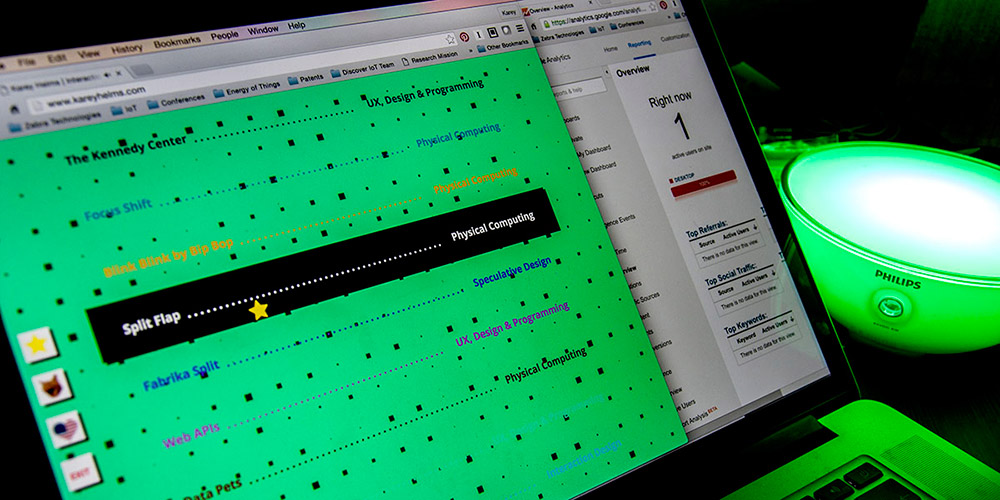How might Internet of Things interactions translate across time and space?
Phygital Party Mode is an exploratory autobiographical design project, in which visitors’ interactions with my website remotely control an Internet of Things light within my apartment. When a visitor enters ‘Party Mode’ at the bottom of the homepage, my portfolio transforms into a musical instrument. Using a combination of digital and physical prototyping tools – Google Polymer, Firebase, Arduino and Philips Hue – my flat is synchronously transformed into a party space.
Karey Helms. Phygital Party Mode: A Relationship with Relationships. ACM Conference on Human Factors in Computing Systems (CHI 2017) Workshop “Designing the Social Internet of Things”, Denver, Colorado, USA 2017.

Background
Phygital Party Mode began in fall of 2013 when I redesigned my online portfolio to include ‘Party Mode,’ a link at the bottom of my website that transforms a list of projects into a musical instrument. Upon entering Party Mode, an electronic beat and background animations play. As a website visitor moves their cursor over an individual project name, an associated sound plays and the background color changes. The original intention of Party Mode was to make my portfolio a project that represented aspects of my personality alongside my academic and professional design work. After Party Mode went live in 2014, I soon noticed an increase in the frequency of which I was checking my website analytics, for which I was constantly curious of visitors’ interactions and reactions. I wanted to experience their experience. This consequently led to Phygital Party Mode, an updated version in which user interactions within Party Mode not only control sound and color within the website, but also simultaneously control the color of a Phillips Hue Go, an Internet of Things light, in my apartment.
Reflections
[1] When disparate ‘things’ have the ability to connect via open source Internet of Things, agency shifts between designers, end-users, and the technology. What are the consequences of democratizing configuration, participation, maintenance, and creativity?
[2] With data a material and participation a medium, our ‘things’ are not only physical and personal, but are also digital and social. How does this transform our relationships with ‘things’ and each other?
[3] The behaviors of ’things’ are expected to become increasingly complex as they become technologically embedded and connected. Should the responsibility lie in the ‘thing’ to communicate status, symptoms, and intent or should designers focus on empowering people?
Design Decisions
The key factor that contributed to the manifestation of visitor interactions with Phygital Party Mode into the color of a Philips Hue Go is that each project is associated with a unique color, whereas some projects are associated with the same sound. The individual color association was a deliberate decision unrelated to Party Mode to facilitate a visual mental mapping of projects relative to the portfolio as a whole. In contrast, the audio association is due to an initial technical constraint in which individual sounds from a limited array are reused as the number of projects is greater than the array length. Consequently, as a visitor interacts with Phygital Party Mode, I can discern which project they are interacting with based on color, without altering the preexisting technical configuration.
Technical Implementation
Phygital Party Mode uses the following technologies: HTML, CSS, JavaScript, Firebase, Philips Hue API and an Arduino Yún.
The front-end website experience is constructed in HTML, CSS and JavaScript. When a user clicks on Party
Mode, a status variable within a Firebase database is updated to ‘on.’ Subsequent hover interactions with individual projects update a secondary database table with the associated project color. An Arduino Yún watches the database and sends the most recent color variable over Wi-Fi to the Philips Hue Bridge, changing the light hue in real-time.
Firebase and an Arduino Yún are needed as intermediary technologies because the Philips Hue API is local and cannot be accessed outside of the Wi-Fi network.
Future Iterations
Following reflection, in future iterations of Phygital Party Mode I would investigate synchronous and asynchronous interactions. In the current instantiation, real-time interactions are the focus, resulting in both delight and disruption. With the implementation of deliberate time-based thresholds, convenient interactions could be immediately enacted and inconvenient interactions could be strategically delayed. While this solution potentially dilutes serendipitous moments, it affords the exploration of behaviors from the intermixing of multiple user interactions in a single historical playback. Therefore, designing for synchronous and asynchronous interactions would further explore the themes of active versus reactive agency and designing the behavior of objects.